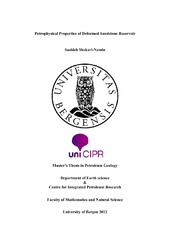Petrophysical Properties of Deformed Sandstone Reservoir
Master thesis
Permanent lenke
https://hdl.handle.net/1956/6053Utgivelsesdato
2012-06-21Metadata
Vis full innførselSamlinger
- Department of Earth Science [1050]
Sammendrag
Small scale deformation structures that mostly occur in highly porous rocks are called deformation bands. Petrophysical characteristics of deformation bands are different from those of host rock and they can act as barriers or conduit to fluid flow. The effect on fluid flow is the most important property of these structures which is essential in many geological fields; for instance oil & gas, CO2 storage and ground water flow, when permeability and capillary pressure are the two major characteristics of the reservoir under study. In this study, fluid flow experiments have been conducted on deformed sandstone sample from Moab member of Entrada Formation in Waterfall Canyon, Utah which contains cataclastic deformation bands. We have visualized one- and two-phase fluid flow in the deformed sandstone. According to Gamma-Ray scanning, the bands in this sample are denser than host rock and porosity and permeability in these bands were expected to be lower than the surrounding un-deformed rocks. In miscible displacement experiment, five brine floods through sandstone with deformation bands was monitored using real time X-Ray image scanning instrument. To visualize the flow of fluids through the sample, injection water was saturated by Natrium Iodine (NaI) tracer. Removal of NaI tracer was done by injecting water saturated with NaCl with the same density of NaI. In two phase experiment, first a full saturation of sample with NaI as water phase was performed and thereafter draining of that was done using n-Decane (C10H22 ) as oil phase. Saturation in sample for water phase and oil phase has been estimated as 55% and 45%, respectively. Five experiments were performed with different inlet and outlet settings. The flow pattern showed a complex, but repeatable trace of fluids through the sample as fluids crossed deformation bands at same place in all experiments. In the two phase experiment the oil did not completely replace the brine which might be due to increased capillary pressure in the deformation bands. Thin section study was performed on the same sample after the experiments to estimate porosity and permeability from Back scatter Electron Image analysis (BSE) of the deformation bands as well as the host sandstone. Estimated permeability for deformation bands are between 350mD and 900 mD and for host rock is between 1500mD and 2000 mD. Flow experiments and porosity and permeability estimated from BSE are in agreement with each other and the former works (e. g. Torabi et al, in press, Torabi & Fossen 2009 and Antonellini & Aydin, 1994) showing lower porosity and permeability in deformation bands comparing to host rock. Furthermore, this work gains insight into the actual flow of fluids through deformed sandstones by visualizing the flow pattern.
